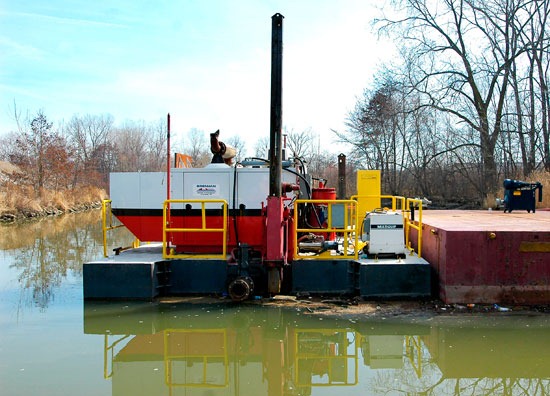Dredging in Ottawa River aims to undo years of toxic contamination
3
A dredge on the Ottawa River in Toledo, Ohio.
Long plagued by runoff and discharges from landfills, industrial facilities, and several sewer outlets that overflow after heavy rain, the Ottawa River in northern Ohio has been called the state’s most polluted waterway. Starting earlier this month, though, cleanup of the river partially funded by Great Lakes Legacy Act has begun.
The Ottawa carries its pollutants directly into Lake Erie’s Maumee Bay, which is why the Legacy Act is contributing to funding of a massive dredging of the river. The operation aims to clean 240,000 cubic yards of contaminated sediment from a 5.5-mile stretch of the river near downtown Toledo, one of the most massive cleanups in Great Lakes history.
Half of the $49 million cost will come from the Legacy Act. The Ottawa River Group will cover the other half. The group includes seven businesses that the U.S. Fish and Wildlife Service pursued legal action against in 2004 for their contribution to pollution in the river. The City of Toledo is providing space in its municipal landfill for the project.
Roughly 7,000 cubic yards of the sediment, however, is so toxic with PCBs that it will be treated separately and sent to a landfill in Michigan licensed to handle such waste.
Despite efforts over the last 10 years to contain some of the river’s pollution sources — capping landfills, cleaning industrial sites, and preventing sewer overflows — it remains wrought with toxic chemicals that endanger humans and the local aquatic ecosystem.
Sediment in the river is contaminated with a combination of cancer-causing polychlorinated biphenyls, or PCBs; polycyclic aromatic hydrocarbons (PAHs); and heavy metals. The project’s goal is to reduce the human and environmental impacts caused by these chemicals.
The dredging operation will run 24 hours a day, except Sundays, through October, according to The Toledo Blade. Crews are using hydraulic cutterhead dredges, which literally suck the sediment from the river bottom like a vacuum cleaner and pump it to a nearby landfill for processing. The sucked up water will be treated and then returned to the river.
Signed into law in 2002, the Great Lakes Legacy Act provides funding to clean up contaminated sediment in “areas of concern” that feed into the Great Lakes. The Legacy Act aims to facilitate the cleanups at the 31 of 43 Great Lakes AOC sites located wholly or partially within U.S. borders.
Great Lakes Legacy Act Ottawa River Cleanup Has Begun [U.S. Environmental Protection Agency] $49M dredging under way on Ottawa River [The Toledo Blade]
Image Credit: Dave Hochanadel














[…] This post was mentioned on Twitter by Dave Poulson, Lake Scientist . Lake Scientist said: The EPA is helping fund a $49 million cleanup of the Ottawa River. Do you think it will make a difference? http://bit.ly/9qKYMT #GreatLakes […]
I wish this project much success. I am glad that there is more and more support for cleaning up our mistakes.
[…] Great Lakes Legacy Act, and its success has set an example for similar restoration projects. The Ottawa River dredging project, for example, is modeled closely after […]